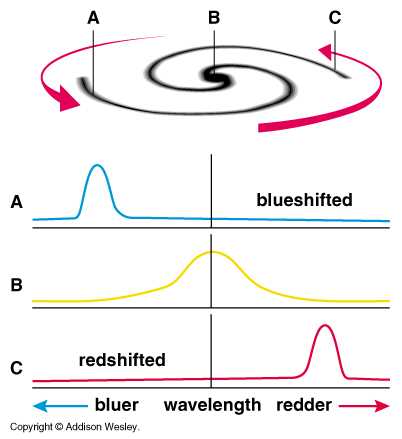
The rotation of our galaxy and many others have been measured using Doppler shifts of the 21cm (radio) line of hydrogen (from The Essential Cosmic Perspective, Bennett et al.)
Key points: Evidence for dark matter; ideas for what it is; Evidence for Dark Energy
 |
The rotation velocity of a galaxy can be measured from Doppler shifts
of its spectral lines. With the distance of the galaxy known, we can use Kepler/Newton
laws to compute the mass of the galaxy; in fact, we can map the mass as a function of the
distance from the center of the galaxy. The rotation of our galaxy and many others have been measured using Doppler shifts of the 21cm (radio) line of hydrogen (from The Essential Cosmic Perspective, Bennett et al.) |
| We find that galaxies do not rotate as if all their mass were in the
visible stars (as in the animation to the near right), but instead rotate at almost a
constant rate no matter the distance from their centers (as in the animation to the far
right). (from Clem Pryke, http://find.uchicago.edu/~pryke/dasi/documents/200309_plancourse/mgp00001.html)
|
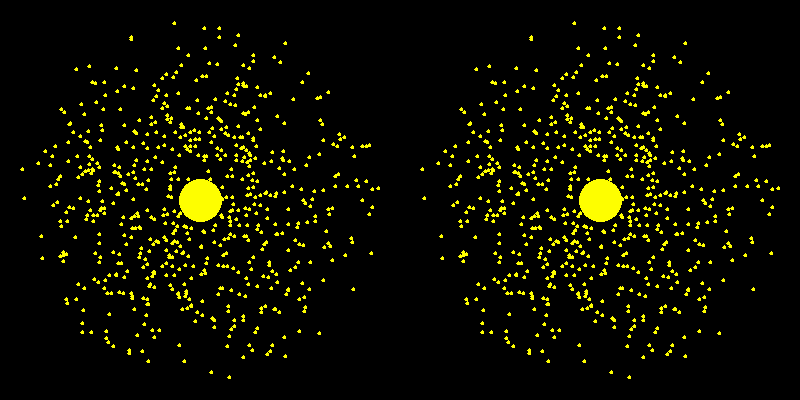 |
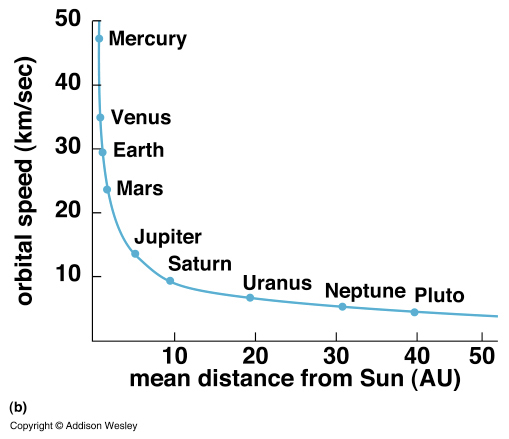 |
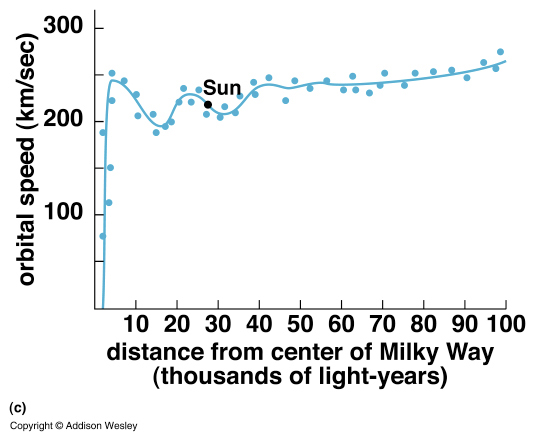 |
| If the mass followed the "normal" matter -- stars and gas -- the rotation speed would drop like the "Keplerian motion" line, like for the planets. Then their speeds would be as we derived when we were discussing Kepler's Laws. This relation assumes essentially all the mass is in the central object (the sun for the planetary system). | Instead, the rotation curve is nearly flat with increasing radius. Evidently there are huge amounts of unseen "dark" matter in the outer parts of the galaxy that add gravitational field beyond that just from the center, causing the stars and gas to orbit faster. (Figures from The Essential Cosmic Perspective, by Bennett et al.) |
 |
Like the Milky Way, virtually all galaxies have flat rotation curves to well beyond where they have many stars, indicating that they are all surrounded by large halos of dark matter. (From The Essential Cosmic Perspective, by Bennett et al.) |
When we account carefully for the mass in stars in a galaxy, it turns out to be much less than the mass we measure from Newton's laws! In addition, there appears to be mass we can't see outside the region occupied by the stars. As much of 90% of galaxies may be in some form of unseen mass.
We have no good idea of what galaxies are mostly made!! Is there some basic particle of physics that we don't know about that accounts
for the unseen mass? This is evidently the dark matter we know played such a central role
in shaping the Universe, but all we know about local examples is from galaxy rotation
curves.![]() A good link for
further information is at http://www.eclipse.net/~cmmiller/DM/.
A good link for
further information is at http://www.eclipse.net/~cmmiller/DM/.
Dark Energy
 |
Type 1 supernovae were measured to be fainter
than expected from a standard cosmological model at high redshift. These
supernovae should be excellent standard candles because they result when gas
acquired by a white dwarf from a binary companion tips the white dwarf over
the Chrandasekhar limit (1.4M
To left: from Supernova Cosmology Project, Knop et al., Lawrence Berkeley National Laboratory, http://supernova.lbl.gov/ |
Thus, the distance measurements using Type 1 supernovae indicate that the expansion of the Universe is getting faster.
Brian Schmidt at the Nobel Prize ceremony |
We sort of explain this behavior as being due to "dark energy" that exerts a repulsive force and therefore makes the Universe tend to fly apart. It turns out that Einstein had included a term in his equations that can fit this behavior, although he thought it had been a mistake! Although we have a name for it, it is really new physics that we do not understand. It might arise from some error in our law of gravity, that is a failure of Einstein's theory of general relativity. Or it is possible that space is filled with something very dilute that creates a repulsive field. Or perhaps it is just that Einstein's extra term was the ultimate stroke of genius! Three astronomers -- Saul Permutter, Brian Schmidt, and Adam Riess received the 2012 Nobel Prize for discovering dark energy -- Schmidt is a product of the University of Arizona! |
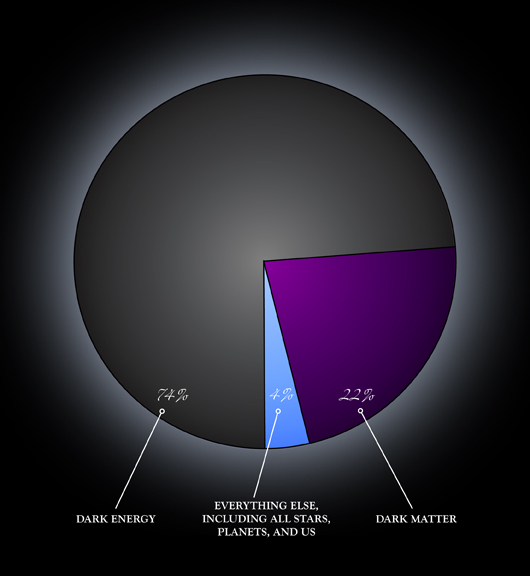 |
If we attribute mass to the dark energy
through E=mc2, then it dominates the mass of the Universe.
http://chandra.harvard.edu/photo/2008/darkenergy/more.html It is humbling, perhaps even humiliating, that we know almost nothing about 96% of what is "out there"!! |
 |
It is likely that dark energy will alter the
possible fates of the Universe we discussed
previously. The expansion started to slow under the influence of gravity
but about half way back to the Big Bang dark energy caused it to start to
speed up again.
(from Chandra Photo Album,
http://chandra.harvard.edu/photo/2004/darkenergy/animations.html)
What eventually happens depends on the behavior of the dark energy with time, and since we don't know what it is we certainly don't know how it is going to behave billions of years from now. (from http://www.scholarpedia.org/article/Dark_energy) |
Test your understanding before going on![]()
|
Galaxy quilt, by Paula van der Zwaan, from http://members.lycos.nl/hollandquilt/id211.htm
|
In the 18th Century, Thomas Wright proposed that theUniverse was filled with groupings of stars like the Milky Way, fromhttp://homepage.mac/com/kvmagruder/bcp/milky/shape.htm |
|
Click to return to syllabus |
||
| Click to return to Types of Galaxies | hypertext |
Click to go to Distribution of Galaxies in Space |